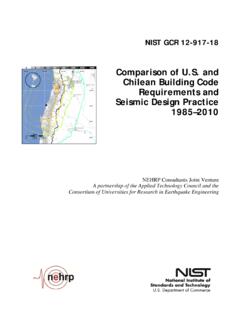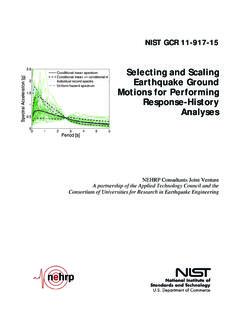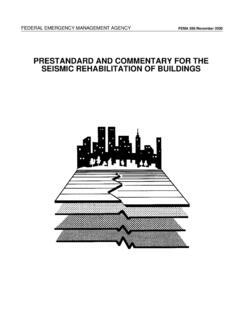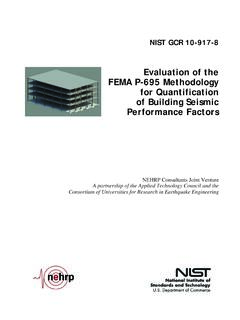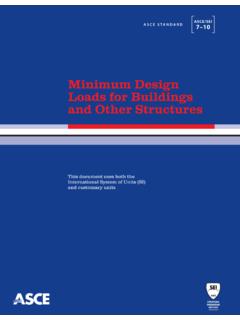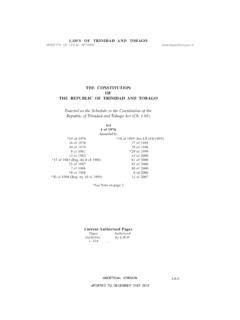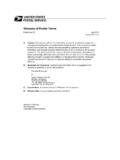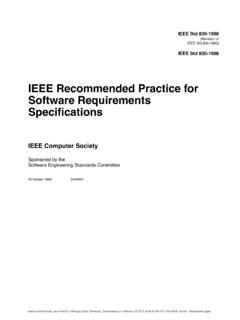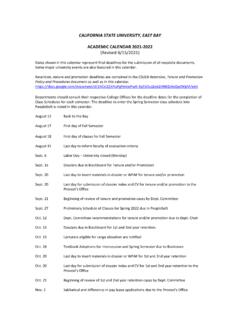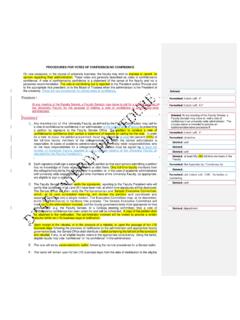Transcription of ASCE 41-13: Seismic Evaluation and Retrofit Rehabilitation ...
1 SEAOC 2012 CONVENTION PROCEEDINGS 1 ASCE 41-13: Seismic Evaluation and Retrofit Rehabilitation of Existing Buildings Robert Pekelnicky, SE Degenkolb Engineers San Francisco, CA Chris Poland, SE, NAE Degenkolb Engineers Oakland, CA Abstract For the past 3 years the ASCE/SEI Standards Committee on Seismic Rehabilitation has been working to combine ASCE 31-03 into ASCE 41-06 while also updating both standards. The result of that humongous effort is the soon-to-be released ASCE 41-13: Seismic Evaluation and Retrofit of Existing Buildings. The new combined standard has eliminated any inconsistencies that previously existed between the two standards. Now the user decides if they want to go forward with lower performance objectives traditionally used for existing buildings, as was the case within ASCE 31 or an equivalent hazard to a new building, similar to the Basic Safety Objective in ASCE 41.
2 In addition, the Tier 1 checklists have been significantly modified and reorganized. The use deficiency-only procedures (Tier 2) have been greatly expanded to regular buildings of greater heights. Plus, there have been a number of significant technical changes including updated analysis provisions with more emphasis on nonlinear response history analysis, provisions for bucking restrained braced frames, expanded liquefaction provisions, a new foundation rocking analysis procedure, substantially updated URM provisions, and a full updated Chapter on Seismic isolation and Energy dissipation. Introduction ATC 14 (1987) and FEMA 273 (1997) were both landmark documents. Each represented major turning points in how the profession addressed evaluating the Seismic hazards posed by existing buildings and mitigating those hazards through Retrofit .
3 ATC 14 created the concept of screening buildings for potential deficiencies which had been observed in similar buildings in major earthquakes to increase a building s risk to life safety. FEMA 273 was the first time that displacement-based methodologies were set forth and guidelines for nonlinear analysis of all types of building structures were provided. Prior to those documents, Seismic Evaluation and Retrofit was left solely to the judgment of the practitioner as he or she attempted to use standards intended for new building design to evaluate and Retrofit existing buildings. Following the publication of both ATC 14 and FEMA 273, the Federal Emergency Management Agency (FEMA) began to support efforts to transition those documents from guidelines into national standards.
4 Those efforts produced updated documents in pre-standard form (FEMA 178, 1992; FEMA 310, 1998; and FEMA 356, 2000). In addition to altering the text of those documents to be enforceable standards language, many technical updates were also incorporated. Also, the displacement based analysis procedures from FEMA 273 were simplified and incorporated into FEMA 310 to bring some consistency to the two documents. The standardization efforts culminated with the publication of ASCE 31-03 Seismic Evaluation of Existing Buildings in 2003 and then in 2006 with ASCE 41-06 Seismic Rehabilitation of Existing Buildings. These documents were produced following ASCE s standards development process, which required significant balloting of both pre-standard documents through a diverse committee of practitioners, academics, and industry representatives followed by a public comment period.
5 All comments made throughout the process were responded to by the ASCE/SEI Standards Committee on Seismic Rehabilitation . In one instance significant public comments to ASCE 41-06 led to the publication of a supplement to that document (ASCE, 2008). From ATC 14 through ASCE 31-03 and from FEMA 273 through ASCE 41-06, these documents have found widespread use throughout the profession, especially in California and within the Federal Building Standards RP4, 2 RP6 and RP 8. Regulatory agencies, such as OSHPD and DSA, public building owners, such as the US General Service Administration, and the Department of Veterans Affairs, have directly referenced or permitted the use of these documents to evaluate and Retrofit existing buildings.
6 As the documents were used more and more, inconsistencies were discovered between ASCE 31 and ASCE 41. Many of the inconsistencies were intentional. The most significant being the ingrained philosophy that existing buildings should be given a break when being evaluated and therefore not be held to the same standards as a new building. While another philosophy held that if someone choses to carry out a Seismic Retrofit , they should do so to a performance level commensurate with a new building unless some other performance objective is intentionally and explicitly chosen. Other inconsistencies were created because of the simplification of the ASCE 41 analysis procedures and member acceptance criteria in ASCE 31. Lastly, inconsistencies were created because the base documents, ATC 14 and FEMA 273, were transitioned into standards documents on different schedules, out of phase with each other, with some differences in the committee membership making those revisions.
7 Another issue of consternation within the profession was the inconsistencies between ASCE 41 and ASCE 7 (2010). Many of these inconsistencies had been known since the publication of FEMA 273 and relate to the fundamentally different applications of the two standards. The different applications led to differences in procedures between the two documents. Because ASCE 7 was written for use in the design of new structures, it can employ force-based procedures which utilize a global building ductility factor, the R-factor, based on the details of construction. ASCE 41 uses displacement-based procedures which assess the ductility of each element action (shear, flexure, etc.) individually because the ductility of the individual elements in the structural system may not be consistent with each other.
8 Irrespective of discrepancies within procedures, the intended performance objective for a typical Risk Category II building is the same in ASCE 7 as the Basic Safety Objective in ASCE 41. Also, because ASCE 7 does not contain specific guidance on the use of nonlinear analysis procedures, ASCE 41 has often been used as the basis for new building designs which utilized nonlinear analyses. When the standards committee met in December 2009 to kick-off the update cycle for ASCE 31 and 41, the aforementioned inconsistencies were at the forefront of everyone s mind. Another topic that garnered a lot of discussion was a proposition to combine ASCE 31 and 41 into one standard. At that meeting, the committee broke up into 3 subcommittees. One was tasked with looking at what technical updates to ASCE 41 should be made, another was tasked with looking at what updates and simplifications could be made to the ASCE 31 Tier 1 screening, and the last was tasked with determining if the documents should be combined or stay as separate, but well-coordinated standards.
9 Once the ASCE 41 subcommittee determined the technical updates needed, it created technical issue teams to address all of those updates. Combined Standard The committee chose to combine the standards into one document and coordinate the Evaluation and Retrofit procedures. The combined standards retains the three-tired approach found in ASCE 31-03, while relying on the technical provisions in ASCE 41-06 as the basis for all the analytical procedures. The Tier 1 Screening is essentially the same as it was in ASCE 31-03, with some reorganization and technical changes to the checklists. Those changes are discussed in more detail later in the paper. The Screening is still intended as the first pass that one would make through the building to get familiar with it. It is intended only to be used as an Evaluation method and not for Retrofit design.
10 The Tier 2 Deficiency-Based procedure is now intended to be used for either Evaluation or Retrofit . As before, the user can go further in evaluating all the potential deficiencies identified in the Tier 1 screening or simply chose to fix those potential deficiencies with a Retrofit design. Unlike ASCE 41-06, there is no difference in building size when a deficiency-based Retrofit can be used versus when a deficiency-only Evaluation can be performed. Previously the Retrofit requirements were significantly more restrictive. In order to eliminate inconsistencies within the document, the specific Tier 2 analysis procedures and ASCE 31-03m-factors were eliminated. The user is pointed to the subsequent sections of the standard that are used for Tier 3 for analysis procedures and m-factors.
